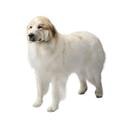Great Pyrenees

Named for the Pyrenees Mountains in Southwestern Europe, the Great Pyrenees is a majestic, faithful and affectionate guardian.
Temperament of the Great Pyrenees Dog
The Great Pyrenees Dog is smart and mellow. Bred to be independent guardians and watchdogs, the Pyr may resist obedience training. He’ll express his boredom by responding to your “heel,” “sit” and “stay” commands as slowly as possible.
Despite the Pyr’s boredom with obedience training, early puppy socialization and training is critical because of his size and territorial nature toward other dogs and strangers.
Although Great Pyrenees are not an overly active breed, daily exercise such as walks around the neighbourhood or play in a fenced yard will help keep them physically and mentally fit.
Breed Characteristics
The Great Pyrenees has a thick, fluffy double coat. His coat and his height give him a majestic, regal appearance.
How Long Do Great Pyrenees Dogs Live?
10 to 12 years
Colours
Standard colours for a Great Pyrenees are white or white with gray, badger, reddish brown or tan markings.
Do Great Pyrenees Shed?
The Great Pyrenees’s double-coat sheds heavily year round. The medium-long coat is weather-proof and tangle-resistant, so it doesn’t require much grooming. Brushing at least once per week will help keep shedding hair from accumulating around the house.
Common Health Conditions
As with other large and giant breeds, Great Pyrenees are susceptible to bloat. You may reduce the risk of bloat by feeding multiple small meals throughout the day and avoid strenuous exercise before or after meals.
Responsible breeders test for common health conditions that may affect the breed, including elbow and hip dysplasia, eye disorders and luxating patella.
Best Dog Food for Great Pyrenees Dogs & Puppies
This giant breed will benefit from a giant- or large-breed dog food formula. Great Pyrenees puppies should eat a large-breed puppy food for the first two years of life, as they take longer to mature than other breeds.
History of the Breed
The Great Pyrenees breed is an ancient one. Pyr remains were found in fossil deposits dating back to the Bronze Age, roughly 1800 to 1000 BC.
The breed was developed to guard livestock and protect herds and flocks from predators like wolves and bears. They worked alongside shepherds and herding dogs in the mountainous region between France and Spain known as the Pyrenees.
Facts
- French royalty were fond of the Pyr, adopting the breed as French court dogs in the 17th century.
- General Lafayette brought the first Great Pyrenees to the U.S. in 1824.
- The Great Pyrenees actually has several different names: Le Grande Chien des Montagnes, which means “the big dog of the mountains,” Le Chien des Pyrenees, which means “the dog of the Pyrenees,” or, as he is known throughout England, the Pyrenean Mountain Dog.
Every dog breed comes with its unique traits that affect their exercise, nutrition, and care needs. Understanding these differences helps provide the best care for your dog, ensuring a healthy, happy, and active life tailored to their breed-specific requirements.